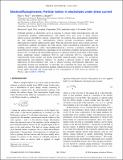Electrodiffusiophoresis: Particle motion in electrolytes under direct current
Author(s)
Rica, Raul A.; Bazant, Martin Z.
DownloadBazant_Electrodiffusiophoresis particle.pdf (1013.Kb)
PUBLISHER_POLICY
Publisher Policy
Article is made available in accordance with the publisher's policy and may be subject to US copyright law. Please refer to the publisher's site for terms of use.
Terms of use
Metadata
Show full item recordAbstract
Colloidal particles in electrolytes move in response to electric fields (electrophoresis) and salt concentration gradients (diffusiophoresis), and related flows also occur at fixed surfaces (electro-osmosis and diffusio-osmosis, respectively). In isolation, these electrokinetic phenomena are well understood, e.g., electrophoresis without far-field concentration gradients and diffusiophoresis without applied electric fields. When the electrolyte passes direct current, however, concentration gradients accompany the bulk electric field (concentration polarization) and the resulting particle motion, called “electrodiffusiophoresis,” involves a nonlinear combination of electrophoresis and diffusiophoresis, depending on ion transference numbers and particle properties. In this work, we analyze the electrodiffusiophoresis of spherical particles in the limit of thin double layers, neglecting surface conduction (Du<<1) and convection (Pe<<1), considering both nonpolarizable (fixed charge) and ideally polarizable (induced-charge) surfaces. Via asymptotic approximations and numerical solutions, we develop a physical picture to guide potential applications in electrochemical cells, such as analyte focusing, electrophoretic deposition, and microfluidic mixing near membranes or electrodes. By controlling the mean salt concentration, particle size, current, and concentration gradient, significant motion of particles (or fluid) is possible toward either electrode and toward high or low concentration.
Date issued
2010-11Department
Massachusetts Institute of Technology. Department of Chemical Engineering; Massachusetts Institute of Technology. Department of MathematicsJournal
Physics of Fluids
Publisher
American Institute of Physics
Citation
Rica, Raúl A., and Martin Z. Bazant. “Electrodiffusiophoresis: Particle motion in electrolytes under direct current.” Physics of Fluids 22.11 (2010) : 112109. © 2010 American Institute of Physics
Version: Final published version
ISSN
1070-6631